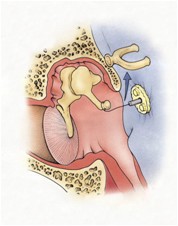The stapes is the third of the three little hearing bones in the middle ear that transmit sound vibrations from the eardrum to the inner ear fluid so that we can hear.
Otosclerosis refers to a bony growth around the stapes, causing it to not vibrate properly and resulting in hearing loss. Stapedectomy is an operation to remove the fixed stapes and to replace it with a prosthesis. This allows sound vibrations to be transmitted properly to the inner ear fluids for hearing.
Who needs the operation?
People with significant conductive type hearing loss confirmed by hearing test will be offered an exploratory tympanotomy operation where the ear drum is lifted to better examine the hearing bones including the stapes. If the stapes is found to be fixed, it will then be removed and a prosthesis is placed. The alternative to perform this operation is hearing aids.
Surgical risk and possible complications:
Commoner risk: failure to improve hearing (< 10%), infection, bleeding, worsening of conductive hearing loss (< 2%), taste loss or disturbance, allergic reaction to packing, dizziness
Less common risk (<1%): facial nerve injury, partial to total sensorineural hearing loss, tinnitus
What would happen if NO operation?
Hearing loss will persist or worsen.
Kevin Ki-Hong Ho, MD
San Francisco
Ear, Nose & Throat Specialist
Golden Gate ENT
Kevin Ki-Hong Ho, MD
San Francisco
Ear, Nose & Throat Specialist
2017 Golden Gate ENT Corp. All rights reserved. Created by Kevin Ho, MD
Kevin Ki-Hong Ho, MD
San Francisco
Ear, Nose & Throat Specialist


